Managing Financial Resources and Decisions for Clariton Antiques Ltd
VerifiedAdded on 2020/01/07
|21
|5686
|209
Report
AI Summary
This report examines the financial resource management and decision-making processes for Clariton Antiques Ltd (CAL). It begins by identifying and assessing various sources of finance available to CAL, including owner's investment, trade credit, leasing, hire purchase, overdrafts, sale of assets, share capital, debt funds, and retained profits. The report then evaluates the impact of each source, considering legal and financial implications, potential for bankruptcy, and dilution of control. Task 2 delves into the comparison of equity and debt financing costs, emphasizing the importance of financial planning, budgeting, and addressing overtrading. It describes the information needs of different decision-makers, such as partners, venture capitalists, and finance brokers. Furthermore, the impact of finance sources on the final accounts is evaluated. Task 3 focuses on budgeting, cost calculations for antique items, and assessing the commercial viability of investment projects. Finally, Task 4 explains the purpose of financial statements, compares appropriate formats for various businesses, and interprets the findings of the final accounts for Clariton Antiques, incorporating ratio analysis to provide strategic financial insights. The report concludes with recommendations for CAL's financial strategy and expansion plans.

Managing financial resources & decisions
1
1
Paraphrase This Document
Need a fresh take? Get an instant paraphrase of this document with our AI Paraphraser
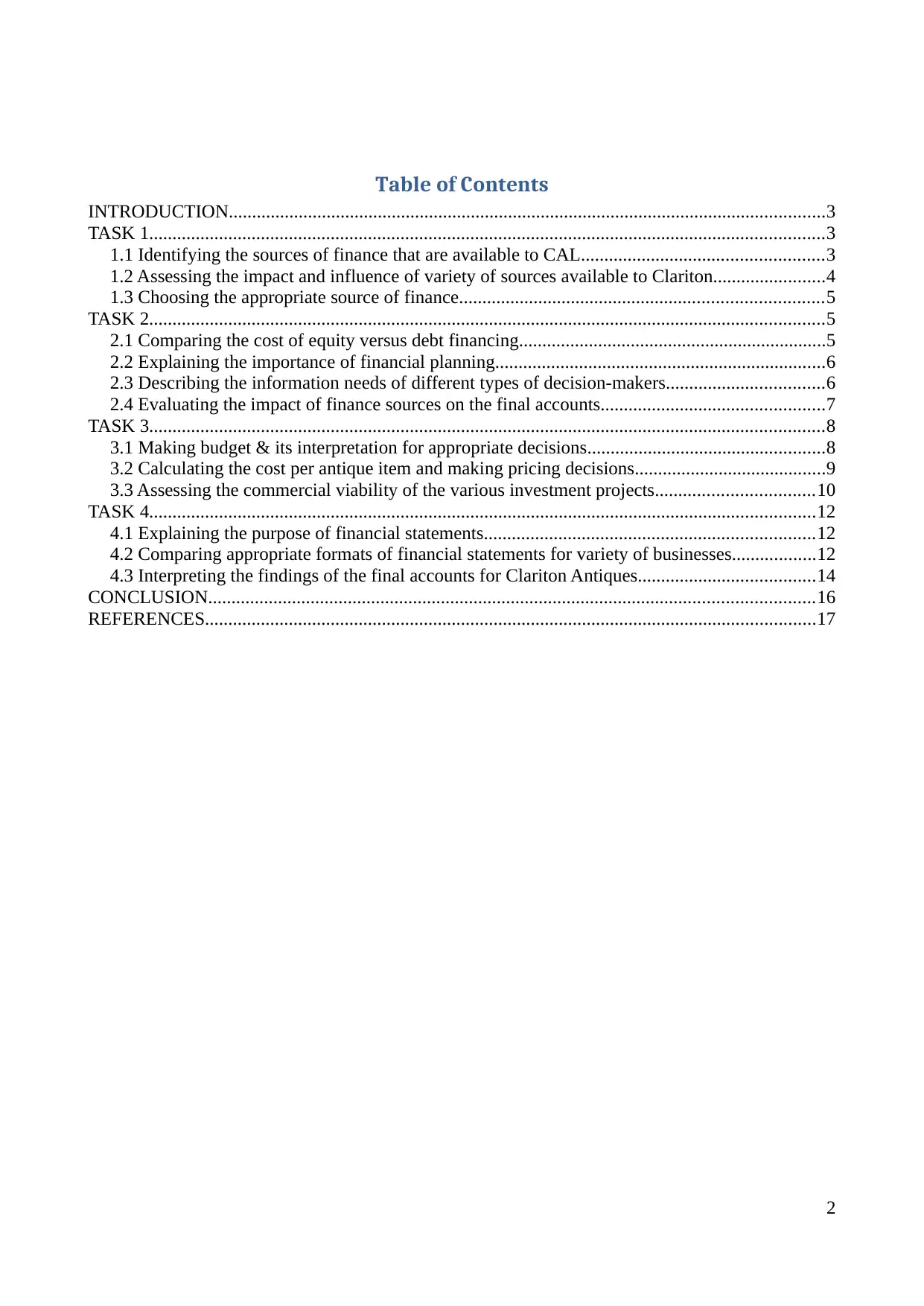
Table of Contents
INTRODUCTION................................................................................................................................3
TASK 1.................................................................................................................................................3
1.1 Identifying the sources of finance that are available to CAL....................................................3
1.2 Assessing the impact and influence of variety of sources available to Clariton........................4
1.3 Choosing the appropriate source of finance..............................................................................5
TASK 2.................................................................................................................................................5
2.1 Comparing the cost of equity versus debt financing..................................................................5
2.2 Explaining the importance of financial planning.......................................................................6
2.3 Describing the information needs of different types of decision-makers..................................6
2.4 Evaluating the impact of finance sources on the final accounts................................................7
TASK 3.................................................................................................................................................8
3.1 Making budget & its interpretation for appropriate decisions...................................................8
3.2 Calculating the cost per antique item and making pricing decisions.........................................9
3.3 Assessing the commercial viability of the various investment projects..................................10
TASK 4...............................................................................................................................................12
4.1 Explaining the purpose of financial statements.......................................................................12
4.2 Comparing appropriate formats of financial statements for variety of businesses..................12
4.3 Interpreting the findings of the final accounts for Clariton Antiques......................................14
CONCLUSION..................................................................................................................................16
REFERENCES...................................................................................................................................17
2
INTRODUCTION................................................................................................................................3
TASK 1.................................................................................................................................................3
1.1 Identifying the sources of finance that are available to CAL....................................................3
1.2 Assessing the impact and influence of variety of sources available to Clariton........................4
1.3 Choosing the appropriate source of finance..............................................................................5
TASK 2.................................................................................................................................................5
2.1 Comparing the cost of equity versus debt financing..................................................................5
2.2 Explaining the importance of financial planning.......................................................................6
2.3 Describing the information needs of different types of decision-makers..................................6
2.4 Evaluating the impact of finance sources on the final accounts................................................7
TASK 3.................................................................................................................................................8
3.1 Making budget & its interpretation for appropriate decisions...................................................8
3.2 Calculating the cost per antique item and making pricing decisions.........................................9
3.3 Assessing the commercial viability of the various investment projects..................................10
TASK 4...............................................................................................................................................12
4.1 Explaining the purpose of financial statements.......................................................................12
4.2 Comparing appropriate formats of financial statements for variety of businesses..................12
4.3 Interpreting the findings of the final accounts for Clariton Antiques......................................14
CONCLUSION..................................................................................................................................16
REFERENCES...................................................................................................................................17
2
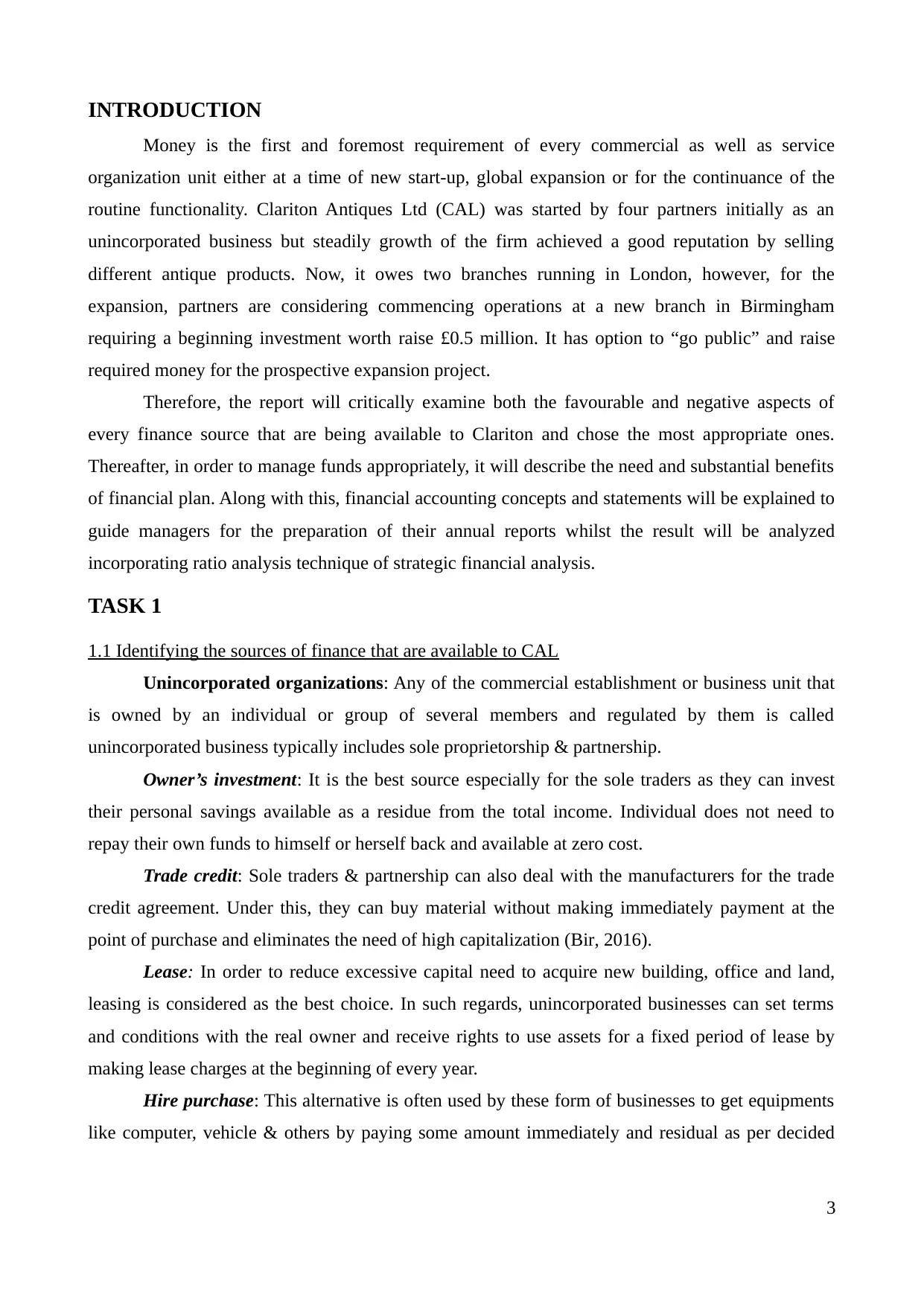
INTRODUCTION
Money is the first and foremost requirement of every commercial as well as service
organization unit either at a time of new start-up, global expansion or for the continuance of the
routine functionality. Clariton Antiques Ltd (CAL) was started by four partners initially as an
unincorporated business but steadily growth of the firm achieved a good reputation by selling
different antique products. Now, it owes two branches running in London, however, for the
expansion, partners are considering commencing operations at a new branch in Birmingham
requiring a beginning investment worth raise £0.5 million. It has option to “go public” and raise
required money for the prospective expansion project.
Therefore, the report will critically examine both the favourable and negative aspects of
every finance source that are being available to Clariton and chose the most appropriate ones.
Thereafter, in order to manage funds appropriately, it will describe the need and substantial benefits
of financial plan. Along with this, financial accounting concepts and statements will be explained to
guide managers for the preparation of their annual reports whilst the result will be analyzed
incorporating ratio analysis technique of strategic financial analysis.
TASK 1
1.1 Identifying the sources of finance that are available to CAL
Unincorporated organizations: Any of the commercial establishment or business unit that
is owned by an individual or group of several members and regulated by them is called
unincorporated business typically includes sole proprietorship & partnership.
Owner’s investment: It is the best source especially for the sole traders as they can invest
their personal savings available as a residue from the total income. Individual does not need to
repay their own funds to himself or herself back and available at zero cost.
Trade credit: Sole traders & partnership can also deal with the manufacturers for the trade
credit agreement. Under this, they can buy material without making immediately payment at the
point of purchase and eliminates the need of high capitalization (Bir, 2016).
Lease: In order to reduce excessive capital need to acquire new building, office and land,
leasing is considered as the best choice. In such regards, unincorporated businesses can set terms
and conditions with the real owner and receive rights to use assets for a fixed period of lease by
making lease charges at the beginning of every year.
Hire purchase: This alternative is often used by these form of businesses to get equipments
like computer, vehicle & others by paying some amount immediately and residual as per decided
3
Money is the first and foremost requirement of every commercial as well as service
organization unit either at a time of new start-up, global expansion or for the continuance of the
routine functionality. Clariton Antiques Ltd (CAL) was started by four partners initially as an
unincorporated business but steadily growth of the firm achieved a good reputation by selling
different antique products. Now, it owes two branches running in London, however, for the
expansion, partners are considering commencing operations at a new branch in Birmingham
requiring a beginning investment worth raise £0.5 million. It has option to “go public” and raise
required money for the prospective expansion project.
Therefore, the report will critically examine both the favourable and negative aspects of
every finance source that are being available to Clariton and chose the most appropriate ones.
Thereafter, in order to manage funds appropriately, it will describe the need and substantial benefits
of financial plan. Along with this, financial accounting concepts and statements will be explained to
guide managers for the preparation of their annual reports whilst the result will be analyzed
incorporating ratio analysis technique of strategic financial analysis.
TASK 1
1.1 Identifying the sources of finance that are available to CAL
Unincorporated organizations: Any of the commercial establishment or business unit that
is owned by an individual or group of several members and regulated by them is called
unincorporated business typically includes sole proprietorship & partnership.
Owner’s investment: It is the best source especially for the sole traders as they can invest
their personal savings available as a residue from the total income. Individual does not need to
repay their own funds to himself or herself back and available at zero cost.
Trade credit: Sole traders & partnership can also deal with the manufacturers for the trade
credit agreement. Under this, they can buy material without making immediately payment at the
point of purchase and eliminates the need of high capitalization (Bir, 2016).
Lease: In order to reduce excessive capital need to acquire new building, office and land,
leasing is considered as the best choice. In such regards, unincorporated businesses can set terms
and conditions with the real owner and receive rights to use assets for a fixed period of lease by
making lease charges at the beginning of every year.
Hire purchase: This alternative is often used by these form of businesses to get equipments
like computer, vehicle & others by paying some amount immediately and residual as per decided
3
⊘ This is a preview!⊘
Do you want full access?
Subscribe today to unlock all pages.

Trusted by 1+ million students worldwide
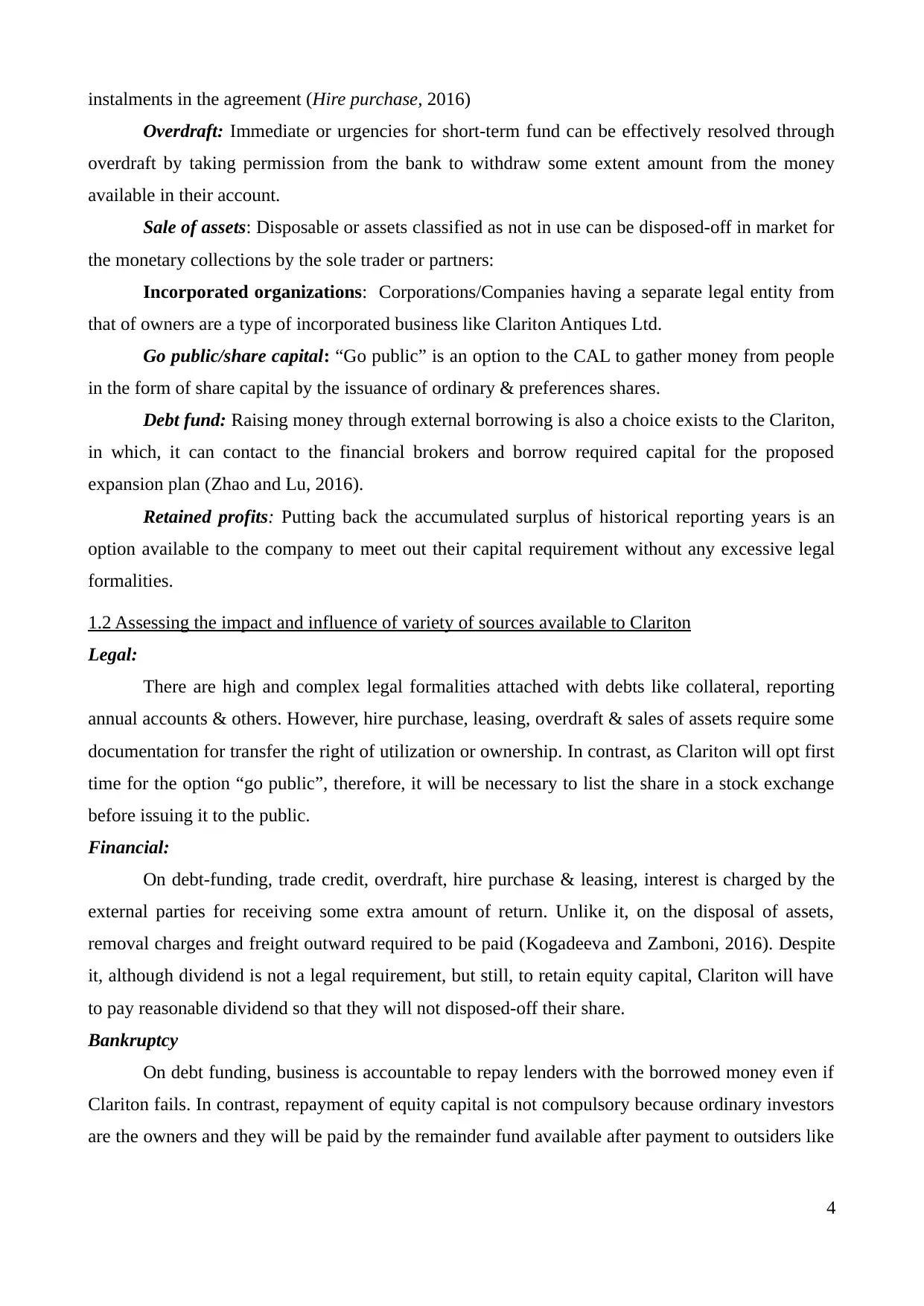
instalments in the agreement (Hire purchase, 2016)
Overdraft: Immediate or urgencies for short-term fund can be effectively resolved through
overdraft by taking permission from the bank to withdraw some extent amount from the money
available in their account.
Sale of assets: Disposable or assets classified as not in use can be disposed-off in market for
the monetary collections by the sole trader or partners:
Incorporated organizations: Corporations/Companies having a separate legal entity from
that of owners are a type of incorporated business like Clariton Antiques Ltd.
Go public/share capital: “Go public” is an option to the CAL to gather money from people
in the form of share capital by the issuance of ordinary & preferences shares.
Debt fund: Raising money through external borrowing is also a choice exists to the Clariton,
in which, it can contact to the financial brokers and borrow required capital for the proposed
expansion plan (Zhao and Lu, 2016).
Retained profits: Putting back the accumulated surplus of historical reporting years is an
option available to the company to meet out their capital requirement without any excessive legal
formalities.
1.2 Assessing the impact and influence of variety of sources available to Clariton
Legal:
There are high and complex legal formalities attached with debts like collateral, reporting
annual accounts & others. However, hire purchase, leasing, overdraft & sales of assets require some
documentation for transfer the right of utilization or ownership. In contrast, as Clariton will opt first
time for the option “go public”, therefore, it will be necessary to list the share in a stock exchange
before issuing it to the public.
Financial:
On debt-funding, trade credit, overdraft, hire purchase & leasing, interest is charged by the
external parties for receiving some extra amount of return. Unlike it, on the disposal of assets,
removal charges and freight outward required to be paid (Kogadeeva and Zamboni, 2016). Despite
it, although dividend is not a legal requirement, but still, to retain equity capital, Clariton will have
to pay reasonable dividend so that they will not disposed-off their share.
Bankruptcy
On debt funding, business is accountable to repay lenders with the borrowed money even if
Clariton fails. In contrast, repayment of equity capital is not compulsory because ordinary investors
are the owners and they will be paid by the remainder fund available after payment to outsiders like
4
Overdraft: Immediate or urgencies for short-term fund can be effectively resolved through
overdraft by taking permission from the bank to withdraw some extent amount from the money
available in their account.
Sale of assets: Disposable or assets classified as not in use can be disposed-off in market for
the monetary collections by the sole trader or partners:
Incorporated organizations: Corporations/Companies having a separate legal entity from
that of owners are a type of incorporated business like Clariton Antiques Ltd.
Go public/share capital: “Go public” is an option to the CAL to gather money from people
in the form of share capital by the issuance of ordinary & preferences shares.
Debt fund: Raising money through external borrowing is also a choice exists to the Clariton,
in which, it can contact to the financial brokers and borrow required capital for the proposed
expansion plan (Zhao and Lu, 2016).
Retained profits: Putting back the accumulated surplus of historical reporting years is an
option available to the company to meet out their capital requirement without any excessive legal
formalities.
1.2 Assessing the impact and influence of variety of sources available to Clariton
Legal:
There are high and complex legal formalities attached with debts like collateral, reporting
annual accounts & others. However, hire purchase, leasing, overdraft & sales of assets require some
documentation for transfer the right of utilization or ownership. In contrast, as Clariton will opt first
time for the option “go public”, therefore, it will be necessary to list the share in a stock exchange
before issuing it to the public.
Financial:
On debt-funding, trade credit, overdraft, hire purchase & leasing, interest is charged by the
external parties for receiving some extra amount of return. Unlike it, on the disposal of assets,
removal charges and freight outward required to be paid (Kogadeeva and Zamboni, 2016). Despite
it, although dividend is not a legal requirement, but still, to retain equity capital, Clariton will have
to pay reasonable dividend so that they will not disposed-off their share.
Bankruptcy
On debt funding, business is accountable to repay lenders with the borrowed money even if
Clariton fails. In contrast, repayment of equity capital is not compulsory because ordinary investors
are the owners and they will be paid by the remainder fund available after payment to outsiders like
4
Paraphrase This Document
Need a fresh take? Get an instant paraphrase of this document with our AI Paraphraser
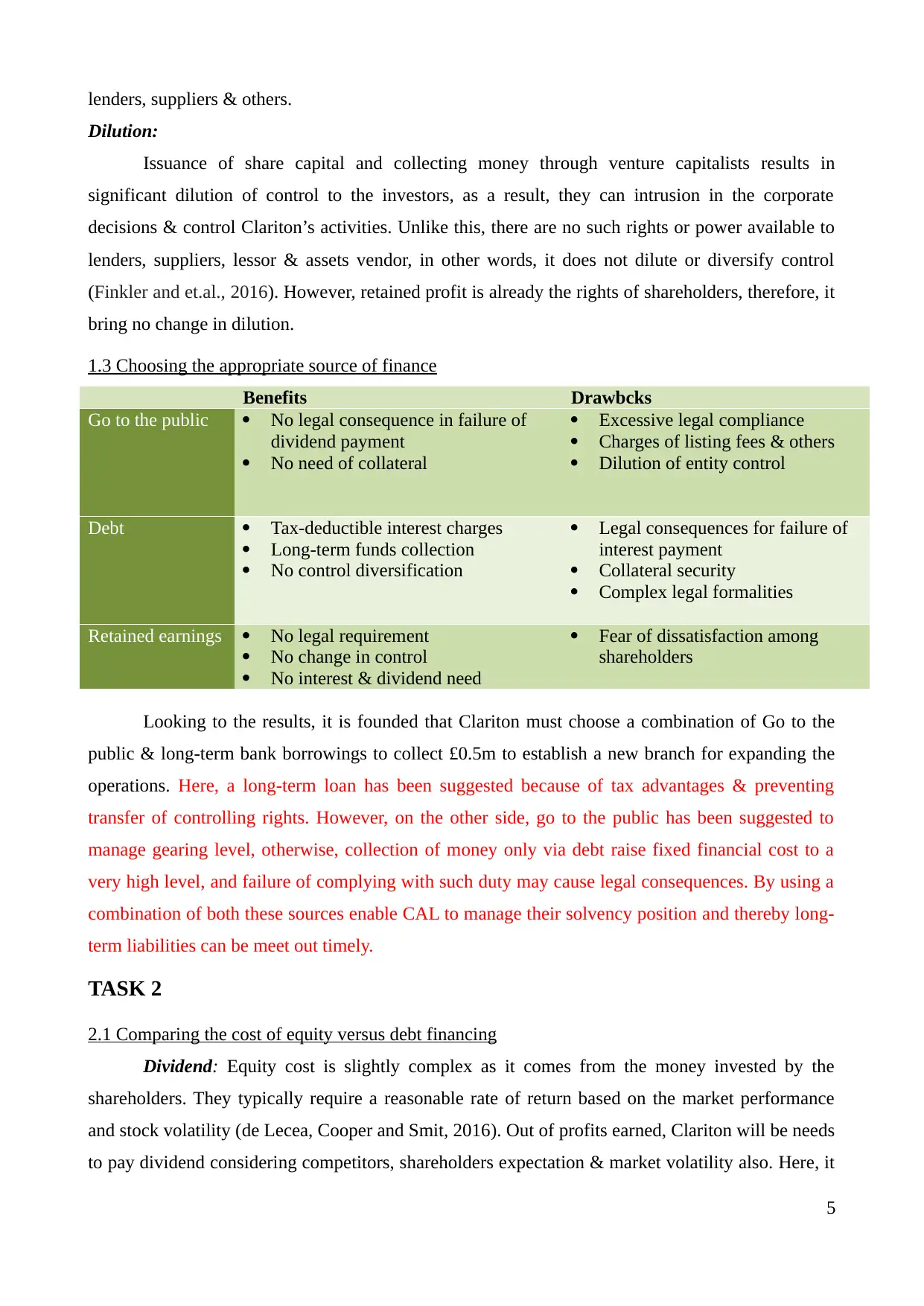
lenders, suppliers & others.
Dilution:
Issuance of share capital and collecting money through venture capitalists results in
significant dilution of control to the investors, as a result, they can intrusion in the corporate
decisions & control Clariton’s activities. Unlike this, there are no such rights or power available to
lenders, suppliers, lessor & assets vendor, in other words, it does not dilute or diversify control
(Finkler and et.al., 2016). However, retained profit is already the rights of shareholders, therefore, it
bring no change in dilution.
1.3 Choosing the appropriate source of finance
Benefits Drawbcks
Go to the public No legal consequence in failure of
dividend payment
No need of collateral
Excessive legal compliance
Charges of listing fees & others
Dilution of entity control
Debt Tax-deductible interest charges
Long-term funds collection
No control diversification
Legal consequences for failure of
interest payment
Collateral security
Complex legal formalities
Retained earnings No legal requirement
No change in control
No interest & dividend need
Fear of dissatisfaction among
shareholders
Looking to the results, it is founded that Clariton must choose a combination of Go to the
public & long-term bank borrowings to collect £0.5m to establish a new branch for expanding the
operations. Here, a long-term loan has been suggested because of tax advantages & preventing
transfer of controlling rights. However, on the other side, go to the public has been suggested to
manage gearing level, otherwise, collection of money only via debt raise fixed financial cost to a
very high level, and failure of complying with such duty may cause legal consequences. By using a
combination of both these sources enable CAL to manage their solvency position and thereby long-
term liabilities can be meet out timely.
TASK 2
2.1 Comparing the cost of equity versus debt financing
Dividend: Equity cost is slightly complex as it comes from the money invested by the
shareholders. They typically require a reasonable rate of return based on the market performance
and stock volatility (de Lecea, Cooper and Smit, 2016). Out of profits earned, Clariton will be needs
to pay dividend considering competitors, shareholders expectation & market volatility also. Here, it
5
Dilution:
Issuance of share capital and collecting money through venture capitalists results in
significant dilution of control to the investors, as a result, they can intrusion in the corporate
decisions & control Clariton’s activities. Unlike this, there are no such rights or power available to
lenders, suppliers, lessor & assets vendor, in other words, it does not dilute or diversify control
(Finkler and et.al., 2016). However, retained profit is already the rights of shareholders, therefore, it
bring no change in dilution.
1.3 Choosing the appropriate source of finance
Benefits Drawbcks
Go to the public No legal consequence in failure of
dividend payment
No need of collateral
Excessive legal compliance
Charges of listing fees & others
Dilution of entity control
Debt Tax-deductible interest charges
Long-term funds collection
No control diversification
Legal consequences for failure of
interest payment
Collateral security
Complex legal formalities
Retained earnings No legal requirement
No change in control
No interest & dividend need
Fear of dissatisfaction among
shareholders
Looking to the results, it is founded that Clariton must choose a combination of Go to the
public & long-term bank borrowings to collect £0.5m to establish a new branch for expanding the
operations. Here, a long-term loan has been suggested because of tax advantages & preventing
transfer of controlling rights. However, on the other side, go to the public has been suggested to
manage gearing level, otherwise, collection of money only via debt raise fixed financial cost to a
very high level, and failure of complying with such duty may cause legal consequences. By using a
combination of both these sources enable CAL to manage their solvency position and thereby long-
term liabilities can be meet out timely.
TASK 2
2.1 Comparing the cost of equity versus debt financing
Dividend: Equity cost is slightly complex as it comes from the money invested by the
shareholders. They typically require a reasonable rate of return based on the market performance
and stock volatility (de Lecea, Cooper and Smit, 2016). Out of profits earned, Clariton will be needs
to pay dividend considering competitors, shareholders expectation & market volatility also. Here, it
5
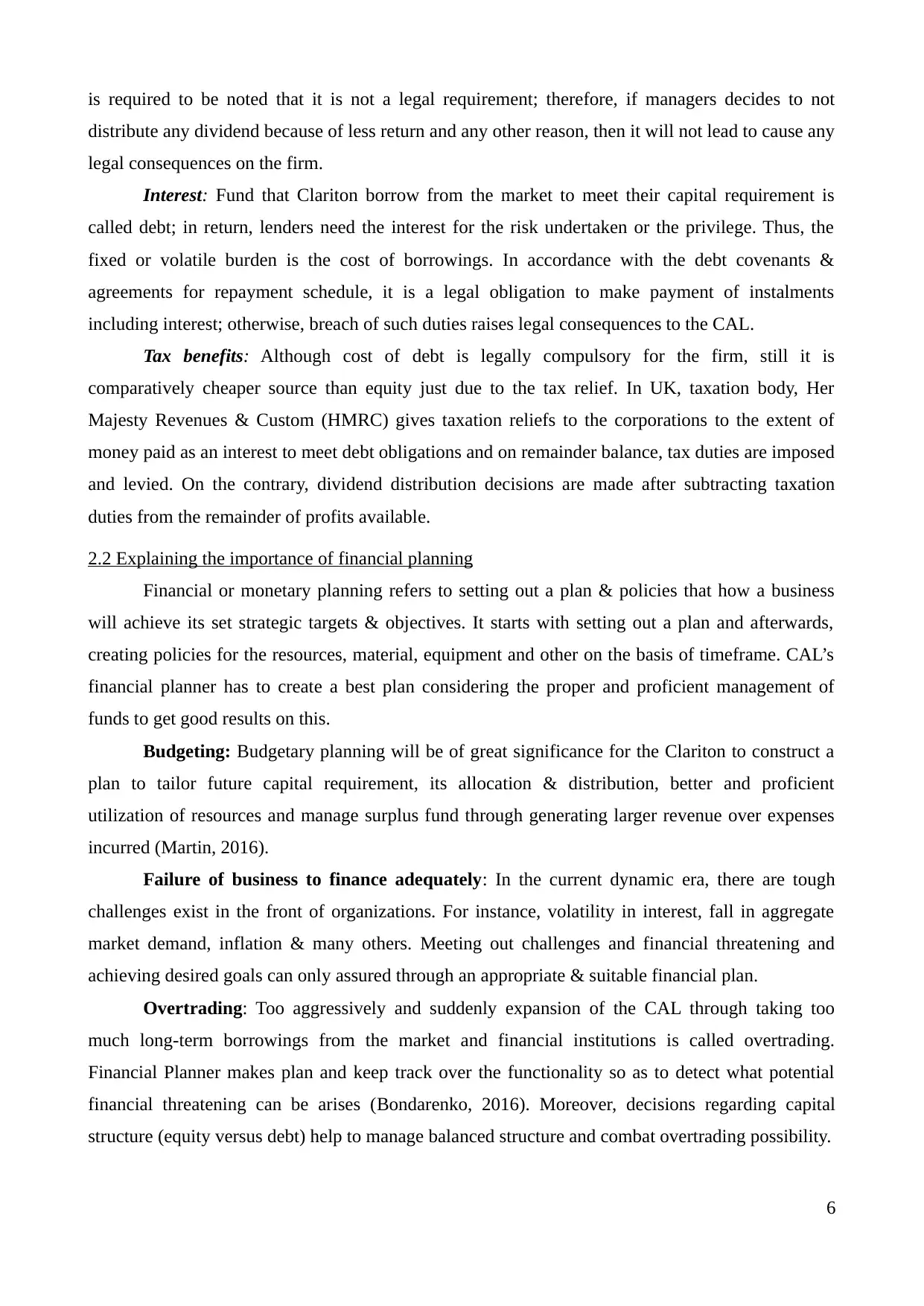
is required to be noted that it is not a legal requirement; therefore, if managers decides to not
distribute any dividend because of less return and any other reason, then it will not lead to cause any
legal consequences on the firm.
Interest: Fund that Clariton borrow from the market to meet their capital requirement is
called debt; in return, lenders need the interest for the risk undertaken or the privilege. Thus, the
fixed or volatile burden is the cost of borrowings. In accordance with the debt covenants &
agreements for repayment schedule, it is a legal obligation to make payment of instalments
including interest; otherwise, breach of such duties raises legal consequences to the CAL.
Tax benefits: Although cost of debt is legally compulsory for the firm, still it is
comparatively cheaper source than equity just due to the tax relief. In UK, taxation body, Her
Majesty Revenues & Custom (HMRC) gives taxation reliefs to the corporations to the extent of
money paid as an interest to meet debt obligations and on remainder balance, tax duties are imposed
and levied. On the contrary, dividend distribution decisions are made after subtracting taxation
duties from the remainder of profits available.
2.2 Explaining the importance of financial planning
Financial or monetary planning refers to setting out a plan & policies that how a business
will achieve its set strategic targets & objectives. It starts with setting out a plan and afterwards,
creating policies for the resources, material, equipment and other on the basis of timeframe. CAL’s
financial planner has to create a best plan considering the proper and proficient management of
funds to get good results on this.
Budgeting: Budgetary planning will be of great significance for the Clariton to construct a
plan to tailor future capital requirement, its allocation & distribution, better and proficient
utilization of resources and manage surplus fund through generating larger revenue over expenses
incurred (Martin, 2016).
Failure of business to finance adequately: In the current dynamic era, there are tough
challenges exist in the front of organizations. For instance, volatility in interest, fall in aggregate
market demand, inflation & many others. Meeting out challenges and financial threatening and
achieving desired goals can only assured through an appropriate & suitable financial plan.
Overtrading: Too aggressively and suddenly expansion of the CAL through taking too
much long-term borrowings from the market and financial institutions is called overtrading.
Financial Planner makes plan and keep track over the functionality so as to detect what potential
financial threatening can be arises (Bondarenko, 2016). Moreover, decisions regarding capital
structure (equity versus debt) help to manage balanced structure and combat overtrading possibility.
6
distribute any dividend because of less return and any other reason, then it will not lead to cause any
legal consequences on the firm.
Interest: Fund that Clariton borrow from the market to meet their capital requirement is
called debt; in return, lenders need the interest for the risk undertaken or the privilege. Thus, the
fixed or volatile burden is the cost of borrowings. In accordance with the debt covenants &
agreements for repayment schedule, it is a legal obligation to make payment of instalments
including interest; otherwise, breach of such duties raises legal consequences to the CAL.
Tax benefits: Although cost of debt is legally compulsory for the firm, still it is
comparatively cheaper source than equity just due to the tax relief. In UK, taxation body, Her
Majesty Revenues & Custom (HMRC) gives taxation reliefs to the corporations to the extent of
money paid as an interest to meet debt obligations and on remainder balance, tax duties are imposed
and levied. On the contrary, dividend distribution decisions are made after subtracting taxation
duties from the remainder of profits available.
2.2 Explaining the importance of financial planning
Financial or monetary planning refers to setting out a plan & policies that how a business
will achieve its set strategic targets & objectives. It starts with setting out a plan and afterwards,
creating policies for the resources, material, equipment and other on the basis of timeframe. CAL’s
financial planner has to create a best plan considering the proper and proficient management of
funds to get good results on this.
Budgeting: Budgetary planning will be of great significance for the Clariton to construct a
plan to tailor future capital requirement, its allocation & distribution, better and proficient
utilization of resources and manage surplus fund through generating larger revenue over expenses
incurred (Martin, 2016).
Failure of business to finance adequately: In the current dynamic era, there are tough
challenges exist in the front of organizations. For instance, volatility in interest, fall in aggregate
market demand, inflation & many others. Meeting out challenges and financial threatening and
achieving desired goals can only assured through an appropriate & suitable financial plan.
Overtrading: Too aggressively and suddenly expansion of the CAL through taking too
much long-term borrowings from the market and financial institutions is called overtrading.
Financial Planner makes plan and keep track over the functionality so as to detect what potential
financial threatening can be arises (Bondarenko, 2016). Moreover, decisions regarding capital
structure (equity versus debt) help to manage balanced structure and combat overtrading possibility.
6
⊘ This is a preview!⊘
Do you want full access?
Subscribe today to unlock all pages.

Trusted by 1+ million students worldwide
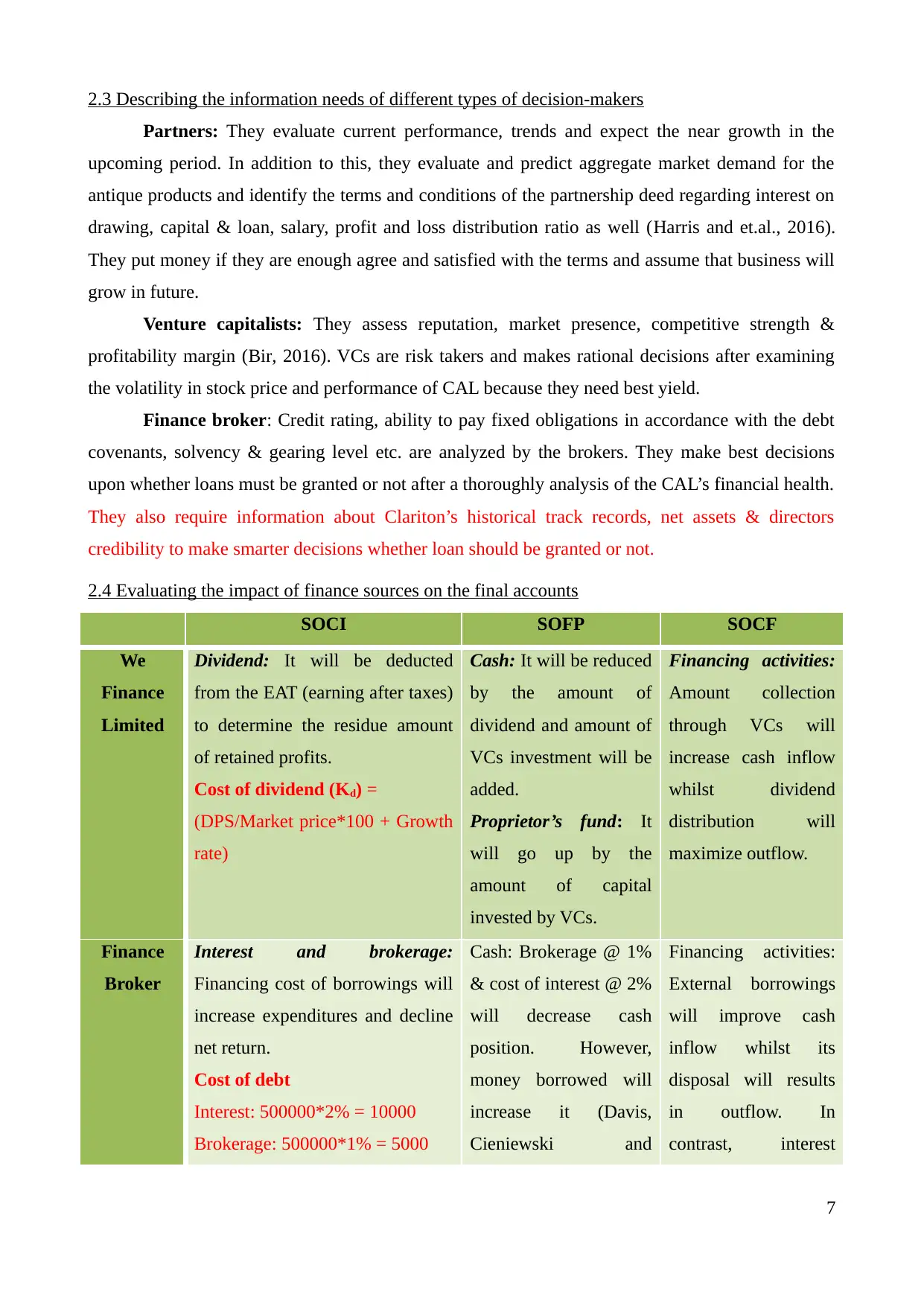
2.3 Describing the information needs of different types of decision-makers
Partners: They evaluate current performance, trends and expect the near growth in the
upcoming period. In addition to this, they evaluate and predict aggregate market demand for the
antique products and identify the terms and conditions of the partnership deed regarding interest on
drawing, capital & loan, salary, profit and loss distribution ratio as well (Harris and et.al., 2016).
They put money if they are enough agree and satisfied with the terms and assume that business will
grow in future.
Venture capitalists: They assess reputation, market presence, competitive strength &
profitability margin (Bir, 2016). VCs are risk takers and makes rational decisions after examining
the volatility in stock price and performance of CAL because they need best yield.
Finance broker: Credit rating, ability to pay fixed obligations in accordance with the debt
covenants, solvency & gearing level etc. are analyzed by the brokers. They make best decisions
upon whether loans must be granted or not after a thoroughly analysis of the CAL’s financial health.
They also require information about Clariton’s historical track records, net assets & directors
credibility to make smarter decisions whether loan should be granted or not.
2.4 Evaluating the impact of finance sources on the final accounts
SOCI SOFP SOCF
We
Finance
Limited
Dividend: It will be deducted
from the EAT (earning after taxes)
to determine the residue amount
of retained profits.
Cost of dividend (Kd) =
(DPS/Market price*100 + Growth
rate)
Cash: It will be reduced
by the amount of
dividend and amount of
VCs investment will be
added.
Proprietor’s fund: It
will go up by the
amount of capital
invested by VCs.
Financing activities:
Amount collection
through VCs will
increase cash inflow
whilst dividend
distribution will
maximize outflow.
Finance
Broker
Interest and brokerage:
Financing cost of borrowings will
increase expenditures and decline
net return.
Cost of debt
Interest: 500000*2% = 10000
Brokerage: 500000*1% = 5000
Cash: Brokerage @ 1%
& cost of interest @ 2%
will decrease cash
position. However,
money borrowed will
increase it (Davis,
Cieniewski and
Financing activities:
External borrowings
will improve cash
inflow whilst its
disposal will results
in outflow. In
contrast, interest
7
Partners: They evaluate current performance, trends and expect the near growth in the
upcoming period. In addition to this, they evaluate and predict aggregate market demand for the
antique products and identify the terms and conditions of the partnership deed regarding interest on
drawing, capital & loan, salary, profit and loss distribution ratio as well (Harris and et.al., 2016).
They put money if they are enough agree and satisfied with the terms and assume that business will
grow in future.
Venture capitalists: They assess reputation, market presence, competitive strength &
profitability margin (Bir, 2016). VCs are risk takers and makes rational decisions after examining
the volatility in stock price and performance of CAL because they need best yield.
Finance broker: Credit rating, ability to pay fixed obligations in accordance with the debt
covenants, solvency & gearing level etc. are analyzed by the brokers. They make best decisions
upon whether loans must be granted or not after a thoroughly analysis of the CAL’s financial health.
They also require information about Clariton’s historical track records, net assets & directors
credibility to make smarter decisions whether loan should be granted or not.
2.4 Evaluating the impact of finance sources on the final accounts
SOCI SOFP SOCF
We
Finance
Limited
Dividend: It will be deducted
from the EAT (earning after taxes)
to determine the residue amount
of retained profits.
Cost of dividend (Kd) =
(DPS/Market price*100 + Growth
rate)
Cash: It will be reduced
by the amount of
dividend and amount of
VCs investment will be
added.
Proprietor’s fund: It
will go up by the
amount of capital
invested by VCs.
Financing activities:
Amount collection
through VCs will
increase cash inflow
whilst dividend
distribution will
maximize outflow.
Finance
Broker
Interest and brokerage:
Financing cost of borrowings will
increase expenditures and decline
net return.
Cost of debt
Interest: 500000*2% = 10000
Brokerage: 500000*1% = 5000
Cash: Brokerage @ 1%
& cost of interest @ 2%
will decrease cash
position. However,
money borrowed will
increase it (Davis,
Cieniewski and
Financing activities:
External borrowings
will improve cash
inflow whilst its
disposal will results
in outflow. In
contrast, interest
7
Paraphrase This Document
Need a fresh take? Get an instant paraphrase of this document with our AI Paraphraser
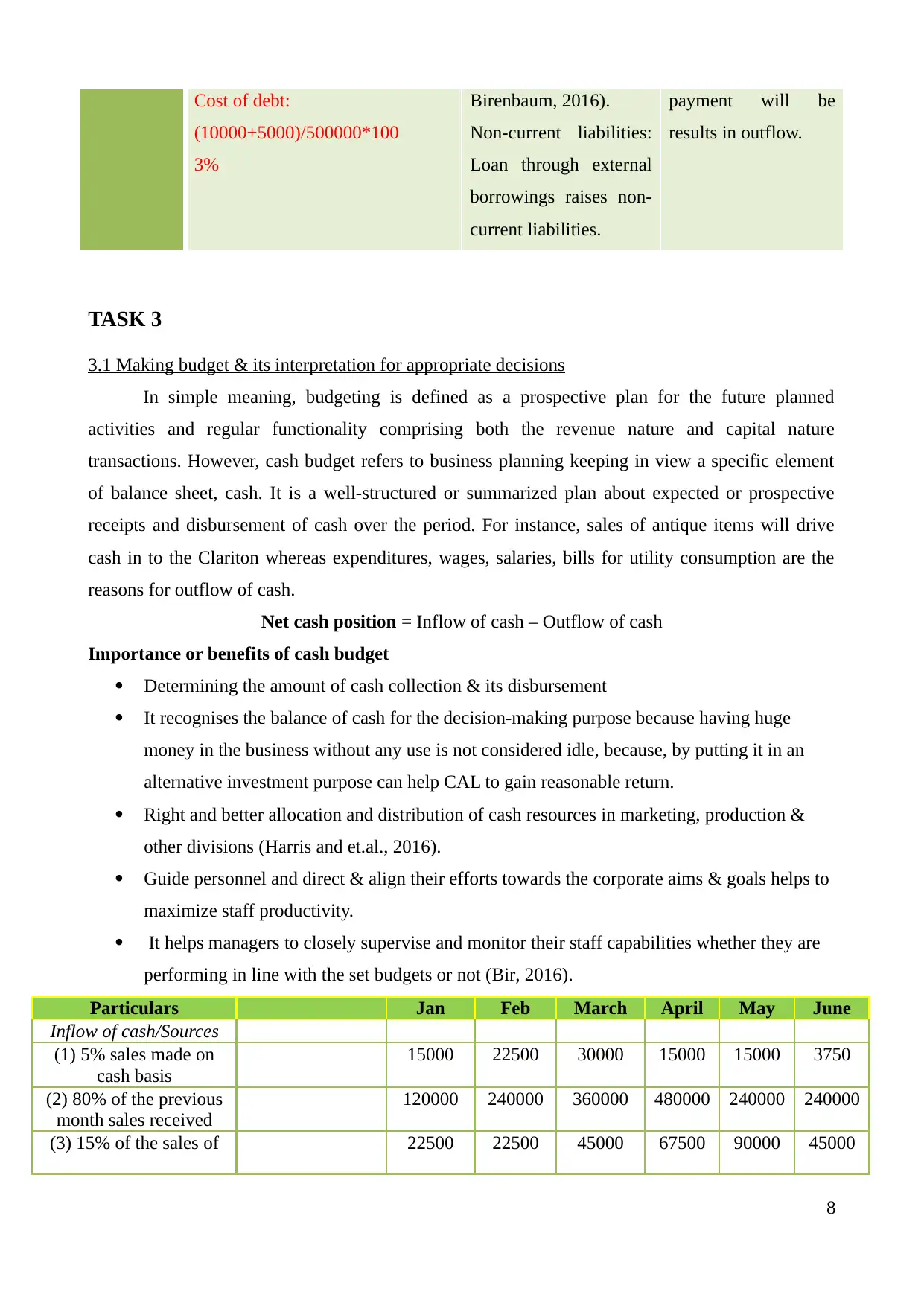
Cost of debt:
(10000+5000)/500000*100
3%
Birenbaum, 2016).
Non-current liabilities:
Loan through external
borrowings raises non-
current liabilities.
payment will be
results in outflow.
TASK 3
3.1 Making budget & its interpretation for appropriate decisions
In simple meaning, budgeting is defined as a prospective plan for the future planned
activities and regular functionality comprising both the revenue nature and capital nature
transactions. However, cash budget refers to business planning keeping in view a specific element
of balance sheet, cash. It is a well-structured or summarized plan about expected or prospective
receipts and disbursement of cash over the period. For instance, sales of antique items will drive
cash in to the Clariton whereas expenditures, wages, salaries, bills for utility consumption are the
reasons for outflow of cash.
Net cash position = Inflow of cash – Outflow of cash
Importance or benefits of cash budget
Determining the amount of cash collection & its disbursement
It recognises the balance of cash for the decision-making purpose because having huge
money in the business without any use is not considered idle, because, by putting it in an
alternative investment purpose can help CAL to gain reasonable return.
Right and better allocation and distribution of cash resources in marketing, production &
other divisions (Harris and et.al., 2016).
Guide personnel and direct & align their efforts towards the corporate aims & goals helps to
maximize staff productivity.
It helps managers to closely supervise and monitor their staff capabilities whether they are
performing in line with the set budgets or not (Bir, 2016).
Particulars Jan Feb March April May June
Inflow of cash/Sources
(1) 5% sales made on
cash basis
15000 22500 30000 15000 15000 3750
(2) 80% of the previous
month sales received
120000 240000 360000 480000 240000 240000
(3) 15% of the sales of 22500 22500 45000 67500 90000 45000
8
(10000+5000)/500000*100
3%
Birenbaum, 2016).
Non-current liabilities:
Loan through external
borrowings raises non-
current liabilities.
payment will be
results in outflow.
TASK 3
3.1 Making budget & its interpretation for appropriate decisions
In simple meaning, budgeting is defined as a prospective plan for the future planned
activities and regular functionality comprising both the revenue nature and capital nature
transactions. However, cash budget refers to business planning keeping in view a specific element
of balance sheet, cash. It is a well-structured or summarized plan about expected or prospective
receipts and disbursement of cash over the period. For instance, sales of antique items will drive
cash in to the Clariton whereas expenditures, wages, salaries, bills for utility consumption are the
reasons for outflow of cash.
Net cash position = Inflow of cash – Outflow of cash
Importance or benefits of cash budget
Determining the amount of cash collection & its disbursement
It recognises the balance of cash for the decision-making purpose because having huge
money in the business without any use is not considered idle, because, by putting it in an
alternative investment purpose can help CAL to gain reasonable return.
Right and better allocation and distribution of cash resources in marketing, production &
other divisions (Harris and et.al., 2016).
Guide personnel and direct & align their efforts towards the corporate aims & goals helps to
maximize staff productivity.
It helps managers to closely supervise and monitor their staff capabilities whether they are
performing in line with the set budgets or not (Bir, 2016).
Particulars Jan Feb March April May June
Inflow of cash/Sources
(1) 5% sales made on
cash basis
15000 22500 30000 15000 15000 3750
(2) 80% of the previous
month sales received
120000 240000 360000 480000 240000 240000
(3) 15% of the sales of 22500 22500 45000 67500 90000 45000
8
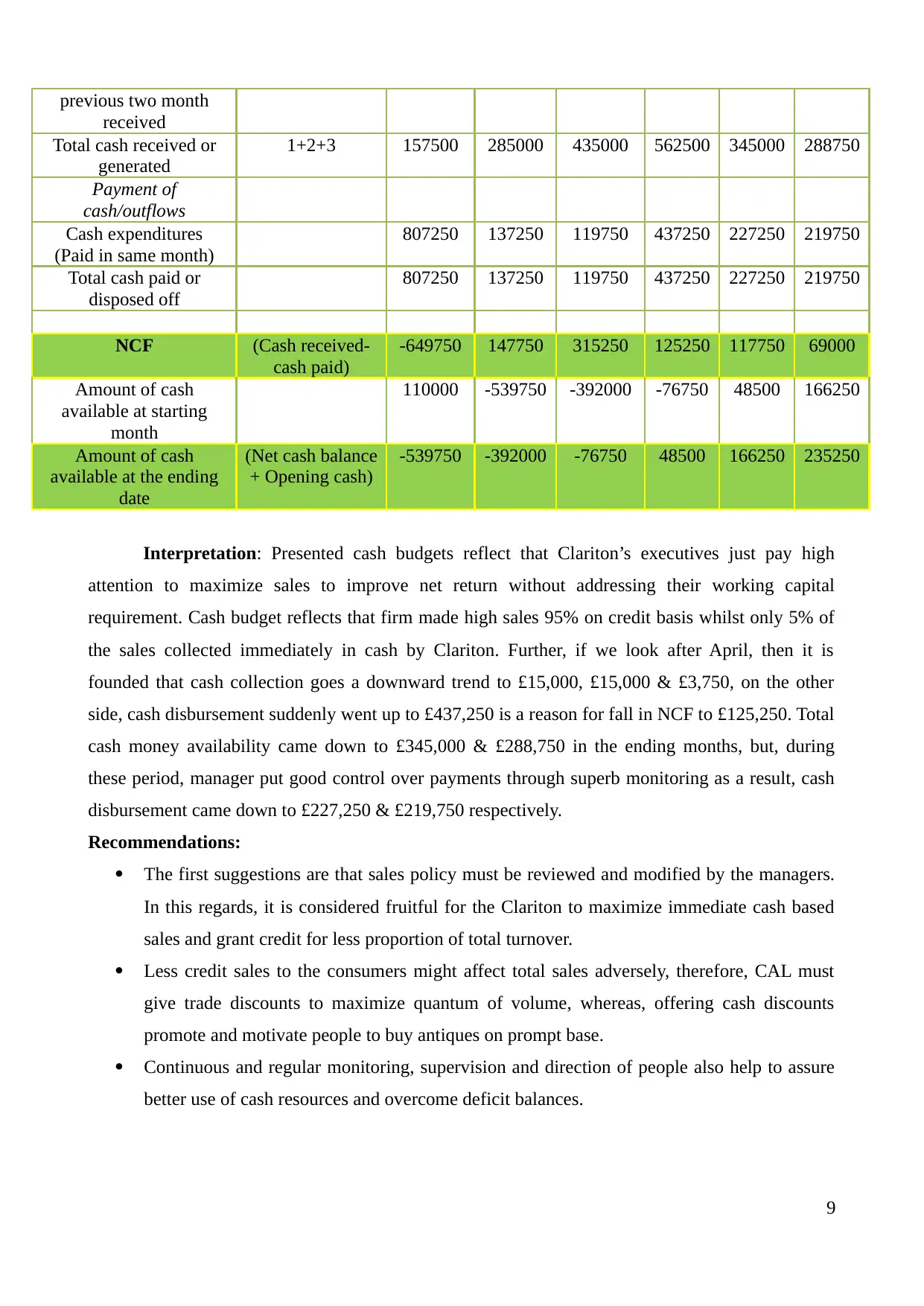
previous two month
received
Total cash received or
generated
1+2+3 157500 285000 435000 562500 345000 288750
Payment of
cash/outflows
Cash expenditures
(Paid in same month)
807250 137250 119750 437250 227250 219750
Total cash paid or
disposed off
807250 137250 119750 437250 227250 219750
NCF (Cash received-
cash paid)
-649750 147750 315250 125250 117750 69000
Amount of cash
available at starting
month
110000 -539750 -392000 -76750 48500 166250
Amount of cash
available at the ending
date
(Net cash balance
+ Opening cash)
-539750 -392000 -76750 48500 166250 235250
Interpretation: Presented cash budgets reflect that Clariton’s executives just pay high
attention to maximize sales to improve net return without addressing their working capital
requirement. Cash budget reflects that firm made high sales 95% on credit basis whilst only 5% of
the sales collected immediately in cash by Clariton. Further, if we look after April, then it is
founded that cash collection goes a downward trend to £15,000, £15,000 & £3,750, on the other
side, cash disbursement suddenly went up to £437,250 is a reason for fall in NCF to £125,250. Total
cash money availability came down to £345,000 & £288,750 in the ending months, but, during
these period, manager put good control over payments through superb monitoring as a result, cash
disbursement came down to £227,250 & £219,750 respectively.
Recommendations:
The first suggestions are that sales policy must be reviewed and modified by the managers.
In this regards, it is considered fruitful for the Clariton to maximize immediate cash based
sales and grant credit for less proportion of total turnover.
Less credit sales to the consumers might affect total sales adversely, therefore, CAL must
give trade discounts to maximize quantum of volume, whereas, offering cash discounts
promote and motivate people to buy antiques on prompt base.
Continuous and regular monitoring, supervision and direction of people also help to assure
better use of cash resources and overcome deficit balances.
9
received
Total cash received or
generated
1+2+3 157500 285000 435000 562500 345000 288750
Payment of
cash/outflows
Cash expenditures
(Paid in same month)
807250 137250 119750 437250 227250 219750
Total cash paid or
disposed off
807250 137250 119750 437250 227250 219750
NCF (Cash received-
cash paid)
-649750 147750 315250 125250 117750 69000
Amount of cash
available at starting
month
110000 -539750 -392000 -76750 48500 166250
Amount of cash
available at the ending
date
(Net cash balance
+ Opening cash)
-539750 -392000 -76750 48500 166250 235250
Interpretation: Presented cash budgets reflect that Clariton’s executives just pay high
attention to maximize sales to improve net return without addressing their working capital
requirement. Cash budget reflects that firm made high sales 95% on credit basis whilst only 5% of
the sales collected immediately in cash by Clariton. Further, if we look after April, then it is
founded that cash collection goes a downward trend to £15,000, £15,000 & £3,750, on the other
side, cash disbursement suddenly went up to £437,250 is a reason for fall in NCF to £125,250. Total
cash money availability came down to £345,000 & £288,750 in the ending months, but, during
these period, manager put good control over payments through superb monitoring as a result, cash
disbursement came down to £227,250 & £219,750 respectively.
Recommendations:
The first suggestions are that sales policy must be reviewed and modified by the managers.
In this regards, it is considered fruitful for the Clariton to maximize immediate cash based
sales and grant credit for less proportion of total turnover.
Less credit sales to the consumers might affect total sales adversely, therefore, CAL must
give trade discounts to maximize quantum of volume, whereas, offering cash discounts
promote and motivate people to buy antiques on prompt base.
Continuous and regular monitoring, supervision and direction of people also help to assure
better use of cash resources and overcome deficit balances.
9
⊘ This is a preview!⊘
Do you want full access?
Subscribe today to unlock all pages.

Trusted by 1+ million students worldwide
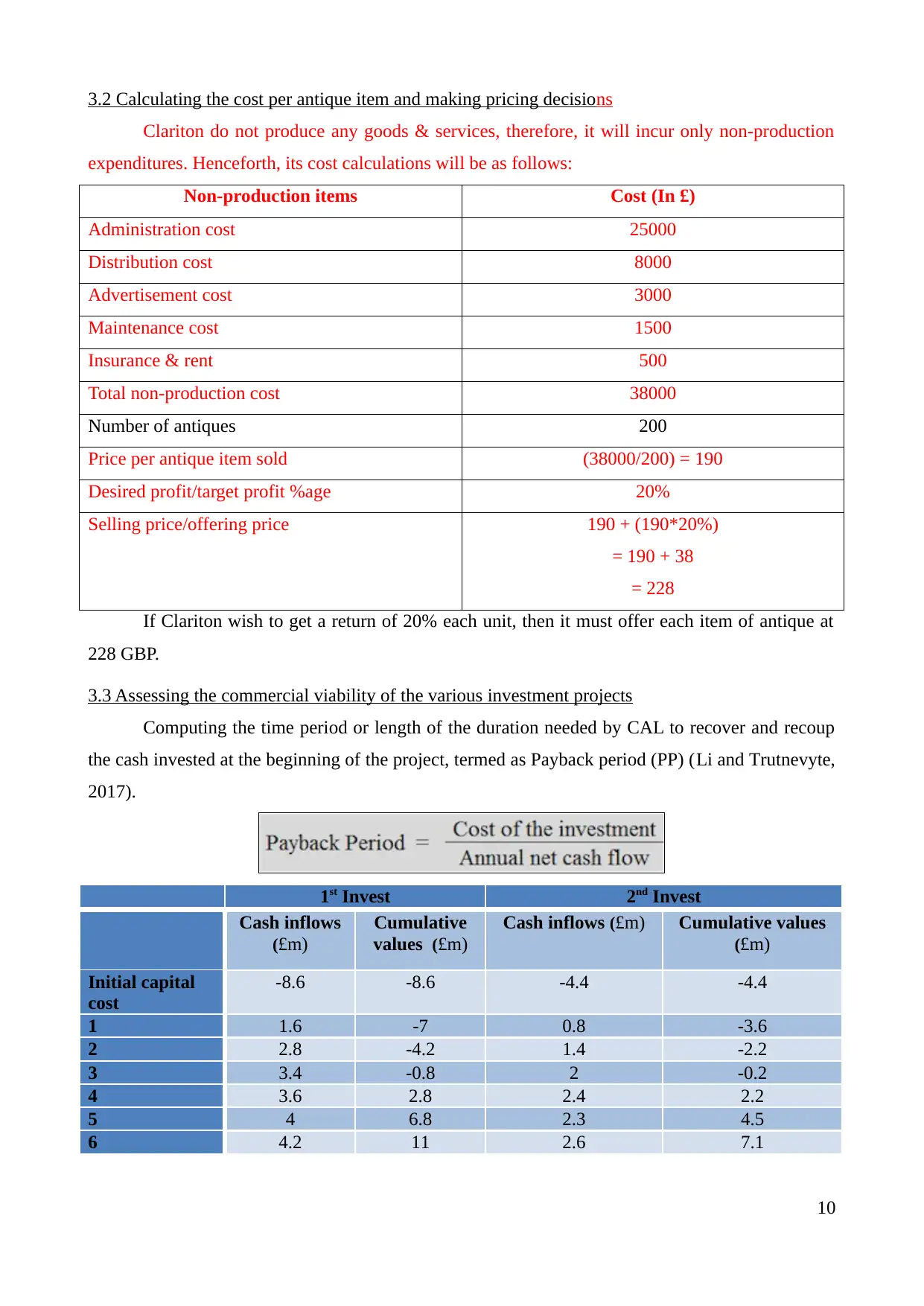
3.2 Calculating the cost per antique item and making pricing decisions
Clariton do not produce any goods & services, therefore, it will incur only non-production
expenditures. Henceforth, its cost calculations will be as follows:
Non-production items Cost (In £)
Administration cost 25000
Distribution cost 8000
Advertisement cost 3000
Maintenance cost 1500
Insurance & rent 500
Total non-production cost 38000
Number of antiques 200
Price per antique item sold (38000/200) = 190
Desired profit/target profit %age 20%
Selling price/offering price 190 + (190*20%)
= 190 + 38
= 228
If Clariton wish to get a return of 20% each unit, then it must offer each item of antique at
228 GBP.
3.3 Assessing the commercial viability of the various investment projects
Computing the time period or length of the duration needed by CAL to recover and recoup
the cash invested at the beginning of the project, termed as Payback period (PP) (Li and Trutnevyte,
2017).
1st Invest 2nd Invest
Cash inflows
(£m)
Cumulative
values (£m)
Cash inflows (£m) Cumulative values
(£m)
Initial capital
cost
-8.6 -8.6 -4.4 -4.4
1 1.6 -7 0.8 -3.6
2 2.8 -4.2 1.4 -2.2
3 3.4 -0.8 2 -0.2
4 3.6 2.8 2.4 2.2
5 4 6.8 2.3 4.5
6 4.2 11 2.6 7.1
10
Clariton do not produce any goods & services, therefore, it will incur only non-production
expenditures. Henceforth, its cost calculations will be as follows:
Non-production items Cost (In £)
Administration cost 25000
Distribution cost 8000
Advertisement cost 3000
Maintenance cost 1500
Insurance & rent 500
Total non-production cost 38000
Number of antiques 200
Price per antique item sold (38000/200) = 190
Desired profit/target profit %age 20%
Selling price/offering price 190 + (190*20%)
= 190 + 38
= 228
If Clariton wish to get a return of 20% each unit, then it must offer each item of antique at
228 GBP.
3.3 Assessing the commercial viability of the various investment projects
Computing the time period or length of the duration needed by CAL to recover and recoup
the cash invested at the beginning of the project, termed as Payback period (PP) (Li and Trutnevyte,
2017).
1st Invest 2nd Invest
Cash inflows
(£m)
Cumulative
values (£m)
Cash inflows (£m) Cumulative values
(£m)
Initial capital
cost
-8.6 -8.6 -4.4 -4.4
1 1.6 -7 0.8 -3.6
2 2.8 -4.2 1.4 -2.2
3 3.4 -0.8 2 -0.2
4 3.6 2.8 2.4 2.2
5 4 6.8 2.3 4.5
6 4.2 11 2.6 7.1
10
Paraphrase This Document
Need a fresh take? Get an instant paraphrase of this document with our AI Paraphraser
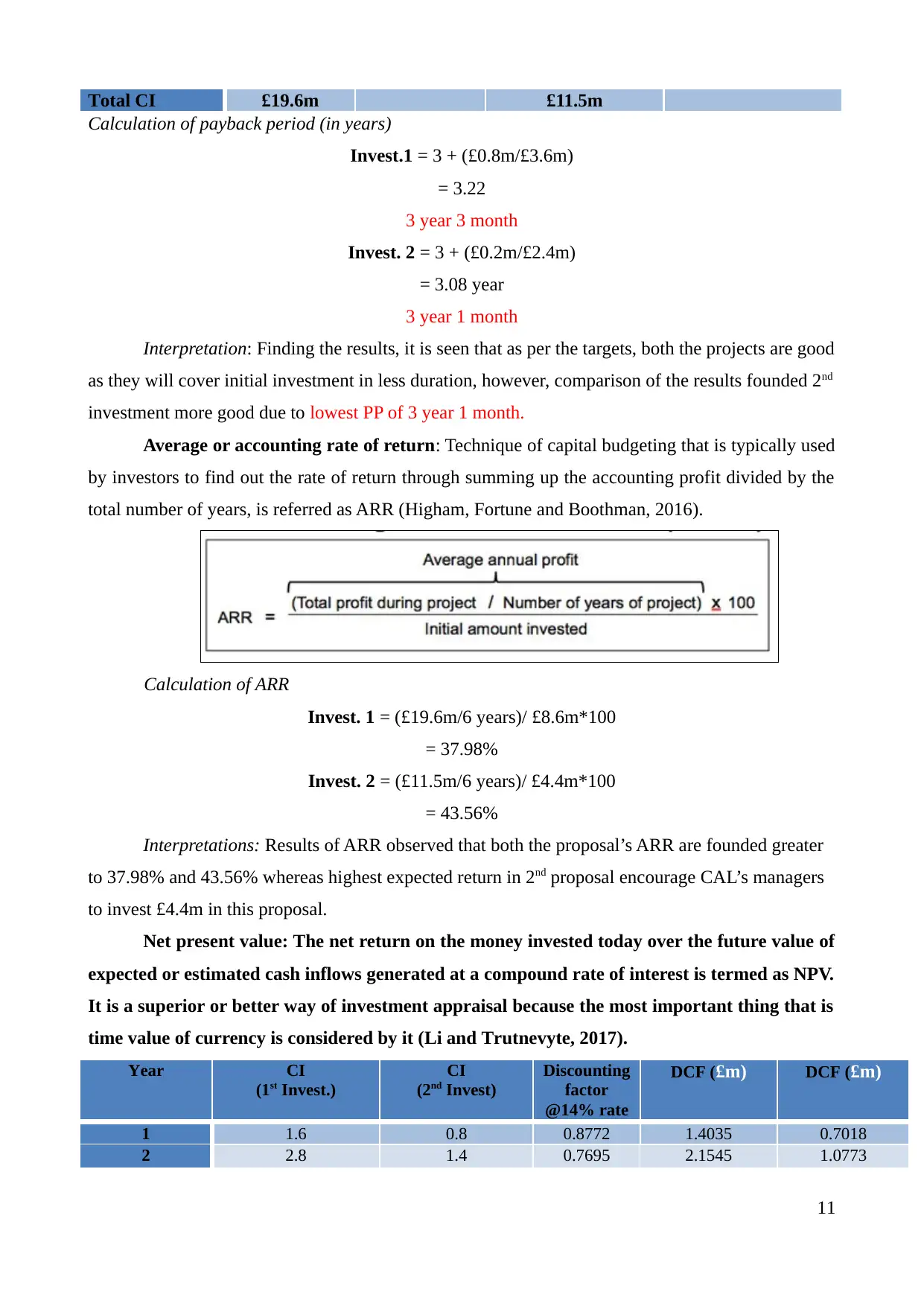
Total CI £19.6m £11.5m
Calculation of payback period (in years)
Invest.1 = 3 + (£0.8m/£3.6m)
= 3.22
3 year 3 month
Invest. 2 = 3 + (£0.2m/£2.4m)
= 3.08 year
3 year 1 month
Interpretation: Finding the results, it is seen that as per the targets, both the projects are good
as they will cover initial investment in less duration, however, comparison of the results founded 2nd
investment more good due to lowest PP of 3 year 1 month.
Average or accounting rate of return: Technique of capital budgeting that is typically used
by investors to find out the rate of return through summing up the accounting profit divided by the
total number of years, is referred as ARR (Higham, Fortune and Boothman, 2016).
Calculation of ARR
Invest. 1 = (£19.6m/6 years)/ £8.6m*100
= 37.98%
Invest. 2 = (£11.5m/6 years)/ £4.4m*100
= 43.56%
Interpretations: Results of ARR observed that both the proposal’s ARR are founded greater
to 37.98% and 43.56% whereas highest expected return in 2nd proposal encourage CAL’s managers
to invest £4.4m in this proposal.
Net present value: The net return on the money invested today over the future value of
expected or estimated cash inflows generated at a compound rate of interest is termed as NPV.
It is a superior or better way of investment appraisal because the most important thing that is
time value of currency is considered by it (Li and Trutnevyte, 2017).
Year CI
(1st Invest.)
CI
(2nd Invest)
Discounting
factor
@14% rate
DCF (£m) DCF (£m)
1 1.6 0.8 0.8772 1.4035 0.7018
2 2.8 1.4 0.7695 2.1545 1.0773
11
Calculation of payback period (in years)
Invest.1 = 3 + (£0.8m/£3.6m)
= 3.22
3 year 3 month
Invest. 2 = 3 + (£0.2m/£2.4m)
= 3.08 year
3 year 1 month
Interpretation: Finding the results, it is seen that as per the targets, both the projects are good
as they will cover initial investment in less duration, however, comparison of the results founded 2nd
investment more good due to lowest PP of 3 year 1 month.
Average or accounting rate of return: Technique of capital budgeting that is typically used
by investors to find out the rate of return through summing up the accounting profit divided by the
total number of years, is referred as ARR (Higham, Fortune and Boothman, 2016).
Calculation of ARR
Invest. 1 = (£19.6m/6 years)/ £8.6m*100
= 37.98%
Invest. 2 = (£11.5m/6 years)/ £4.4m*100
= 43.56%
Interpretations: Results of ARR observed that both the proposal’s ARR are founded greater
to 37.98% and 43.56% whereas highest expected return in 2nd proposal encourage CAL’s managers
to invest £4.4m in this proposal.
Net present value: The net return on the money invested today over the future value of
expected or estimated cash inflows generated at a compound rate of interest is termed as NPV.
It is a superior or better way of investment appraisal because the most important thing that is
time value of currency is considered by it (Li and Trutnevyte, 2017).
Year CI
(1st Invest.)
CI
(2nd Invest)
Discounting
factor
@14% rate
DCF (£m) DCF (£m)
1 1.6 0.8 0.8772 1.4035 0.7018
2 2.8 1.4 0.7695 2.1545 1.0773
11
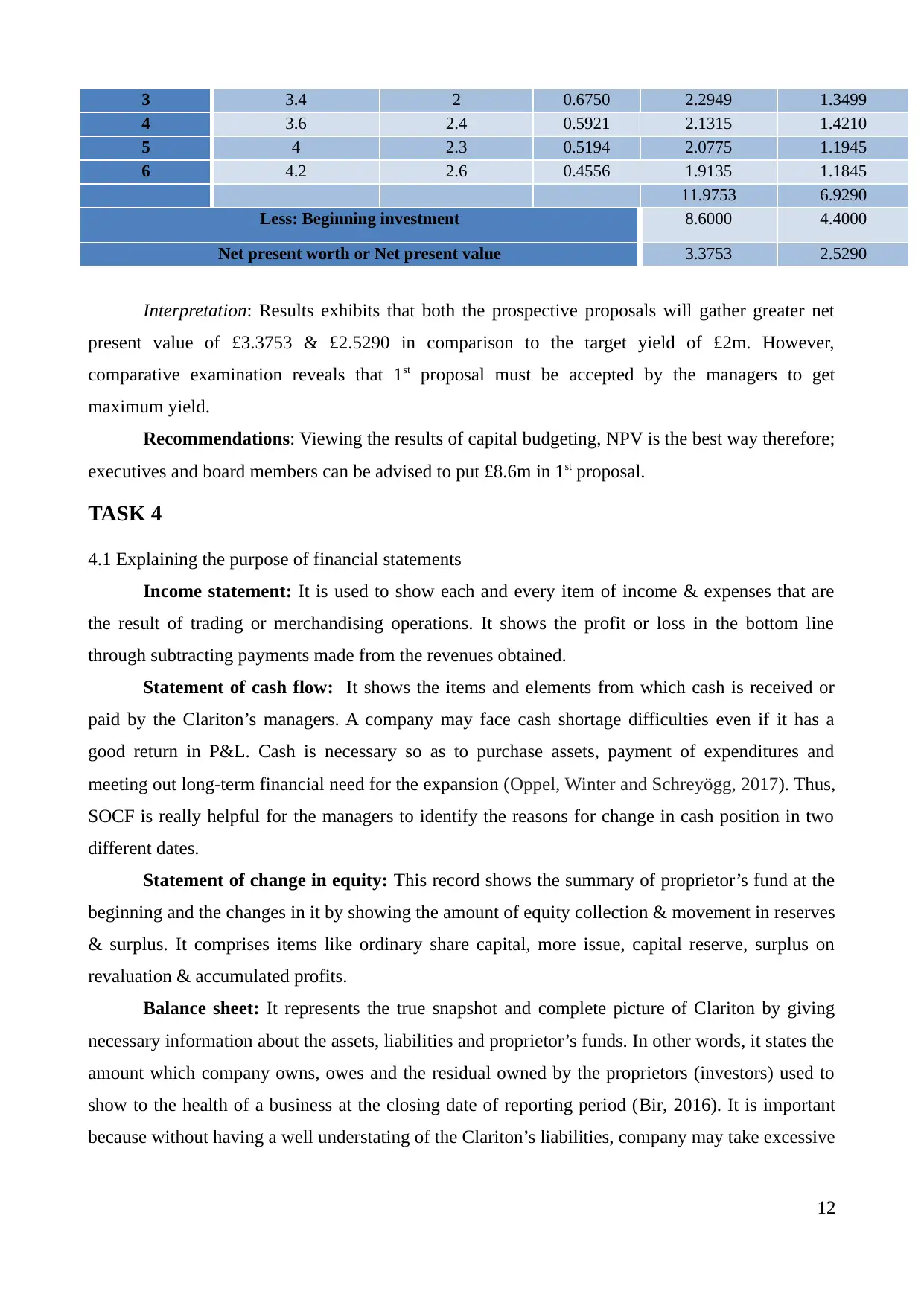
3 3.4 2 0.6750 2.2949 1.3499
4 3.6 2.4 0.5921 2.1315 1.4210
5 4 2.3 0.5194 2.0775 1.1945
6 4.2 2.6 0.4556 1.9135 1.1845
11.9753 6.9290
Less: Beginning investment 8.6000 4.4000
Net present worth or Net present value 3.3753 2.5290
Interpretation: Results exhibits that both the prospective proposals will gather greater net
present value of £3.3753 & £2.5290 in comparison to the target yield of £2m. However,
comparative examination reveals that 1st proposal must be accepted by the managers to get
maximum yield.
Recommendations: Viewing the results of capital budgeting, NPV is the best way therefore;
executives and board members can be advised to put £8.6m in 1st proposal.
TASK 4
4.1 Explaining the purpose of financial statements
Income statement: It is used to show each and every item of income & expenses that are
the result of trading or merchandising operations. It shows the profit or loss in the bottom line
through subtracting payments made from the revenues obtained.
Statement of cash flow: It shows the items and elements from which cash is received or
paid by the Clariton’s managers. A company may face cash shortage difficulties even if it has a
good return in P&L. Cash is necessary so as to purchase assets, payment of expenditures and
meeting out long-term financial need for the expansion (Oppel, Winter and Schreyögg, 2017). Thus,
SOCF is really helpful for the managers to identify the reasons for change in cash position in two
different dates.
Statement of change in equity: This record shows the summary of proprietor’s fund at the
beginning and the changes in it by showing the amount of equity collection & movement in reserves
& surplus. It comprises items like ordinary share capital, more issue, capital reserve, surplus on
revaluation & accumulated profits.
Balance sheet: It represents the true snapshot and complete picture of Clariton by giving
necessary information about the assets, liabilities and proprietor’s funds. In other words, it states the
amount which company owns, owes and the residual owned by the proprietors (investors) used to
show to the health of a business at the closing date of reporting period (Bir, 2016). It is important
because without having a well understating of the Clariton’s liabilities, company may take excessive
12
4 3.6 2.4 0.5921 2.1315 1.4210
5 4 2.3 0.5194 2.0775 1.1945
6 4.2 2.6 0.4556 1.9135 1.1845
11.9753 6.9290
Less: Beginning investment 8.6000 4.4000
Net present worth or Net present value 3.3753 2.5290
Interpretation: Results exhibits that both the prospective proposals will gather greater net
present value of £3.3753 & £2.5290 in comparison to the target yield of £2m. However,
comparative examination reveals that 1st proposal must be accepted by the managers to get
maximum yield.
Recommendations: Viewing the results of capital budgeting, NPV is the best way therefore;
executives and board members can be advised to put £8.6m in 1st proposal.
TASK 4
4.1 Explaining the purpose of financial statements
Income statement: It is used to show each and every item of income & expenses that are
the result of trading or merchandising operations. It shows the profit or loss in the bottom line
through subtracting payments made from the revenues obtained.
Statement of cash flow: It shows the items and elements from which cash is received or
paid by the Clariton’s managers. A company may face cash shortage difficulties even if it has a
good return in P&L. Cash is necessary so as to purchase assets, payment of expenditures and
meeting out long-term financial need for the expansion (Oppel, Winter and Schreyögg, 2017). Thus,
SOCF is really helpful for the managers to identify the reasons for change in cash position in two
different dates.
Statement of change in equity: This record shows the summary of proprietor’s fund at the
beginning and the changes in it by showing the amount of equity collection & movement in reserves
& surplus. It comprises items like ordinary share capital, more issue, capital reserve, surplus on
revaluation & accumulated profits.
Balance sheet: It represents the true snapshot and complete picture of Clariton by giving
necessary information about the assets, liabilities and proprietor’s funds. In other words, it states the
amount which company owns, owes and the residual owned by the proprietors (investors) used to
show to the health of a business at the closing date of reporting period (Bir, 2016). It is important
because without having a well understating of the Clariton’s liabilities, company may take excessive
12
⊘ This is a preview!⊘
Do you want full access?
Subscribe today to unlock all pages.

Trusted by 1+ million students worldwide
1 out of 21
Related Documents
Your All-in-One AI-Powered Toolkit for Academic Success.
+13062052269
info@desklib.com
Available 24*7 on WhatsApp / Email
![[object Object]](/_next/static/media/star-bottom.7253800d.svg)
Unlock your academic potential
Copyright © 2020–2025 A2Z Services. All Rights Reserved. Developed and managed by ZUCOL.





